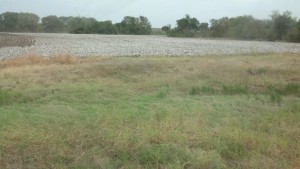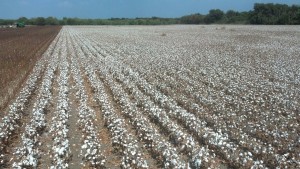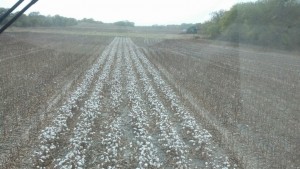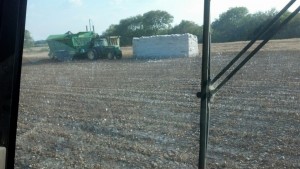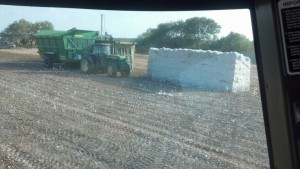My allergist was optimistic in the spring. “Just wait,” he said, back then, “as soon as the temperature goes above 100 degrees, your allergies will be gone.” He was right. When the real Texas heat hit, my allergies ran for cover. It was a relief to my nose, but it was and remained hot for my body for a long time. Now, the autumnal equinox has passed and the cool of fall is in the air. Sadly, the hay fever is again returning to my nose and sinuses.
Just what is hay fever, anyway?
It does start with hay, in the sense that the dust and pollens from the fall-blooming grasses, plants and weeds are what trigger hay fever. Hay fever is your immune system reacting to the pollen granules in your environment. You are having an allergic reaction.
Ok, but how does it work?
We start with some pollen grains from a plant, let’s say from the ragweed plant. Ragweed pollens are tiny enough to be blown by the wind right up your nose. Once in your nose, those little pollens settle down for a stay. You sneeze and blow some back out, but a few ease into the cracks and crannies of you nasal epithelium, the moist skin lining the inside of your nose. A few get even more comfortable, burrowing down and through your skin and right into your body.
That’s when the allergy reaction starts.
Inside your body, there are these odd-looking creatures called immunoglobulins or antibodies. An immunoglobulin (Ig) looks like the letter “Y.” These Y-shaped Ig’s are always looking to identify and subdue intruding bodies, which is why immunoglobulins are also called “antibodies.”
Antibody immunoglobulins move against foreign invaders, which are called allergens. Allergens are thought to be the bad guys. Our ragweed pollens are seen as allergens.
Immunoglobulins are friendlies. They are part of our body’s front line of defense. Immunoglobulins themselves have different names for their different defense corps: IgA, IgD, IgE, IgG and IgM.
Remember the 2002 movie “The Two Towers”? It was the second in Peter Jackson’s “The Lord of the Rings” movie trilogy based on J. R. R. Tolkien’s novels by the same names. Well, in “The Two Towers,” there is this very interesting, oldish, gnarled, moss-bearded tree-creature called appropriately “Treebeard.” Treebeard lives in Fangorn Forest, and Treebeard is an Ent. To me, the “E” in IgE stands for the “E” in Ent. Our “E” immunoglobulins are the ones most involved in the allergy reaction to respond to intruding allergens.
Like Treebeard, immunoglobulin E’s are very tall with long arms and big hands. Ents and IgE’s both resemble big gnarly “Y’s.” They grab those pollens in their big hands at the end of their long arms. Remember how Treebeard grabbed the hobbits Merry and Pippin, whom he thought were allergen invaders. From the perspective of Fangorn Forest and the Ents, the hobbits were allergens, but we know from having seen the movies and read the books that hobbits are really quite nice and not a threat at all. Nonetheless, Treebeard did what good-intentioned IgE’s do best: they react, they grab those allergens, and they take off running seeking further assistance, just like Treebeard.
Where do they go?
That IgEnt is looking for a mast cell. A mast cell is a fully masted battle-flier with a store of trained marines. Far off, Treebeard sites a mast cell. With those big hands, he hales the masted flying machine, jumps aboard, delivers the captured intruder pollens, and makes a full report on the nature and extent of the invasion to Commander Gru.
Fully recovered from his villainy in the 2002 film “Despicable Me” and basking in his positive success (and romance) in “Despicable Me 2,” Gru immediately assesses the situation (perhaps a bit too quickly). Commander Gru turns to Kevin and Bob and orders them to activate the marine minions and respond to the allergen threat. In our bodies, the marine minions are called “histamines.”
Of course, the histamine minions do what minions do best. They overact. Knocking down walls (opening up our blood vessels), flooding the environment (fluids gushing into and out of our noses) and overpowering the amazed allergens beneath mounds of squirming mushy minions (sinus congestion and stuffy nasal passages), they over-respond and manage to do perhaps more damage than good. But, the allergens are certainly subdued. It’s just that the nose and its surroundings are a mess and need some help.
Not to fear, the reformed Dr. Nefario is here to save the day, as he did so well in “Despicable Me 2” (the movie is a delight to watch). With the good Doctor, our family doctors and nurses with their stores of anti-histamines slow down those minions and set things back in place. Thanks, Doc, for helping with the mess.
Most allergy reactions are over-reactions from mis-understandings, like Treebeard not appreciating the nature of hobbits (they really aren’t that bad), Gru moving too fast (ask Margo, Edith and Agnes for their opinions before jumping to the full attack), and minions gone amuck (as only minion can do and do so well.)
Why?
We all move around too much. In the old days, folks lived where they were born; and they had few allergies as adults. They had them plenty as kids. Ever see a kid who didn’t have a runny nose? That’s the way it’s supposed to be. Young bodies need over-reaction to develop the correct immunities, and young bodies are super healthy to handle the over-reactions. After a while, say after five years old, things have been sorted out. The youngsters know the good allergens from the bad ones, and their bodies react appropriately thereafter. Drop a 32-year old or a 52-year old into a new city in a new state in a new country, and those bodies do not have those young experiences. But, the way the body is designed to deal with and learn how to manage allergens is the over-reaction way of Treebeard, Gru and Kevin & Bob. So, allergic over-reactions in adults are to be expected in a global society with everyone on the move. I don’t like to say this, but say it I must: We need to get used to it and find a good allergist.
Until then, there are some great movies out there to distract you from that runny nose.
I guarantee Kevin and Bob will help you feel better — in spite of the mess.
See you at the movies,
Grandpa Jim

